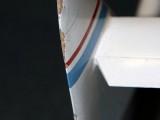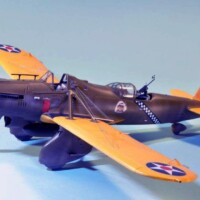Wooden concept models of proposed Orbiter carriers
I was contacted and asked to restore two wooden concept models, I was told, that the models were made by Jack Conroy, the designer of the “Guppy”. Both of the models are very skillfully made and show the real talent and skill of the model maker. Both however definitely show the ravages of time and neglect. both of them had missing parts and damage.
During the early 70’s NASA had an ongoing study of a large aircraft that would carry the orbiter by straddling it in the fashion of a lumber yard gantry crane. The project never went past the drawing board stage and the construction of 1/34 size wind tunnel models. I was told that the "Vitrus" model may have been the wind tunnel model. The study ended due to many factors, one being the cost and the size of the proposed aircraft. Both of the designs had retractable landing gears into the booms. This is not displayed in either of the models.
I was to restore each of the models to as near as could be to the originals.
There were two models:
The first was named “Virtus” and used the fuselages of two B-52’s. It was to be powered by four, Pratt & Whitney JT9D engines. I have no idea of the wing span but I was told that the distance between the two fuselages was 150 feet. The model given to me had originally been build with six engines. None of the engines or mountings were with the model. This model was made entirely of hard wood. I had to recreate the engines as best I could using the SWAG method. I cast each of the engines out of resin.I then repaired all of the damaged areas, primed, and re-painted it.
The second model has no name that I could find and is similar in concept but a different design. The main center section is that of a Constellation. It also was to be 150 feet between the lower booms, This model was made entirely out of balsa wood. It showed some severe damage and it was missing two engines and mounts. I cast the two missing engines out of resin and repaired the damaged areas, primed. and re-painted it.
Each of the models had a wingspan of about 40 inches.




















You've done an excellent job with the restoration, Frank...well done - what is to become of them now?
Craig,
They are in the possession of a person that was very close to Jack Conroy. He plans to display them at his business.
Frank
At first glance I thought they were flying boat prototypes! Nice narrative and a great restoration effort. One day I'll learn how to cast resin properly, what products do you use?
Unbelieveable ! Great work, Frank, on a fantastic restoration.
Really interesting, Frank, and a great, professional job.
I don't think I've ever seen such unusual subjects apart from wierd German '1946' ideas.
Yet another interesting aspect of the modelling craft.
VERY interesting, Frank! Beautiful job on the restorations. I think I saw these in Aviation Week many years ago. Leave it to Conroy to think outside the box, eh?
Frank,
The "before and after" photos really tell a story on these. What a beautiful job. I still think making those engines from scratch was a bit of magic! That is a whole other world to me, what does "SWAG" mean? These restorations you do are often more interesting than building a new kit I would think. Thanks for showing.
Bob
Thanks Bob. Much appreciated. SWAG is the abbreviation of "Scientific Wild A-- Guess"